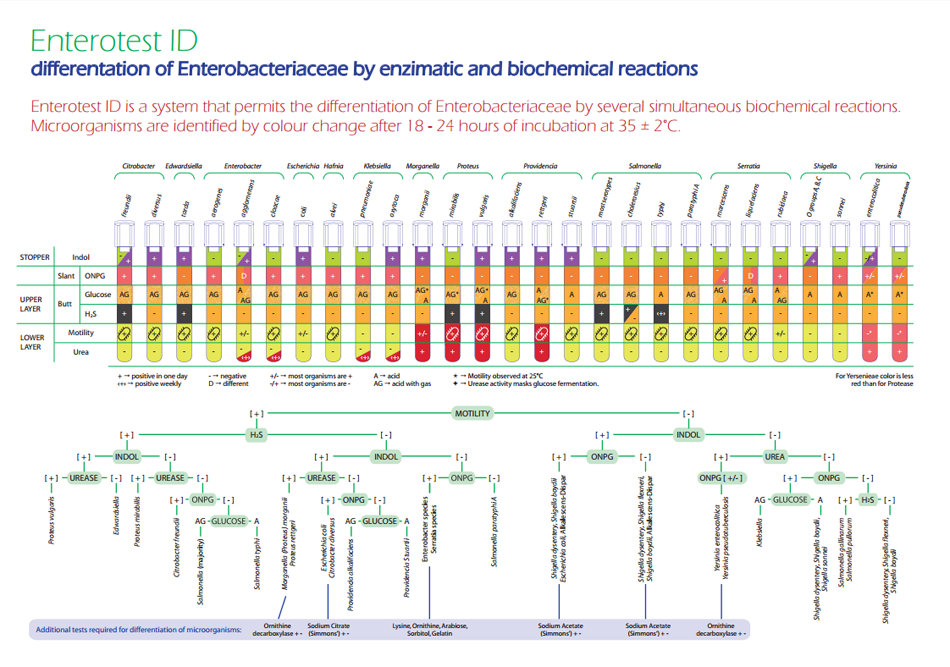HY-ENTEROTEST
- A Rapid,
Simple and Economic Method for Differentiating the Enterobacteriaceae
- Advanced
System for efficient identification of 27 Enterobacteriaceae
- The media
tube contains two layers and a paper cap for indol determination.
- No need
of extra material, lactose free and flexibility to perform other test
Background
Enterobacteriaceae is a
large family of Gram-negative, catalase positive and oxidase negative.
They are
distributed worldwide and may be found in soil, water, plants and
animals. Most
species grow well at 37°C, although some species grow better at
25-30°C. There
is a large number of species included in the family, more than 170, but
the
clinical and more important specimens which play a major role as
infectious
agents, belong to 20 to 25 species that are well known for many years.
The
identification of the members of Enterobacteriaceae
is complicated and has been traditionally based on biochemical and
antigenic
characteristics. Hy-Enterotest, is
a
method well known by microbiologists worldwide, stabbing the butt and
smearing
a slant, for biochemical reactions performed in a simple tube as well
as
bacteria growth motility for further investigations.
The media tube contains:
- Upper layer (3 ml): a butt and a slant with dextrose, ONPG,
enrichments, ferrous sulphate, sodium thiosulfate, agar and phenol-red.
- Lower layer (2 ml): semi-solid media, containing urea,
enrichments, sodium chloride, agar and phenol-red.
- Paper cap for indol determination
PRINCIPLE OF THE METHOD
Hy-Enterotest
system, containing special culture media that permits identification of
the Enterobacteriaceae. The test
allows
simultaneous inoculation of media present in the HY Enterotest system
for the
execution of different biochemical reactions. After 18-24 hours
incubation, microorganism
is identified on the basis of colour as per positive or negative
biochemical
reaction. e.g. glucose fermentation (+ve: yellow; -ve: red) etc.
Hy-Enterotest
gives following essential tests as shown in observation table
| S.No. |
Test |
Principle of the test |
Observation |
| 1 |
Indol Test |
Bacteria
with positive indol test, produce Tryptophanase which breaks down
tryptophan
and release indol which forms red colour complex with Kovac’s or
Ehrlich’s reagent |
Positive-Purple-pink |
| Negative-Colorless |
| 2 |
ONPG Hydrolysis |
β-galactosidase
and permease producing bacteria lead
breakdown of colourless ONPG by β-galactosidase and release yellow
colour
compound O-nitrophenol |
Positive- Orange |
| Negative- Cherry-Pink |
| 3 |
Glucose fermentation (acidity without gas) |
Glucose
fermentative bacteria, results in acid
production which changes pH of media. Due to this, Bromocresol present
in media
turns yellow |
Positive- Yellow |
| Negative- No Change |
| 4 |
Glucose fermentation with CO2 gas formation |
Gas
produced during fermentation can be seen in Durham Tube in the form of
bubble |
Positive- Bubble |
| Negative-No Bubble |
| 5 |
H2S Production |
Bacteria
reduces ferrous Sulphate to Sulphur and produce black colour due to H2S
formation |
Positive-Black |
| Negative-Yellow |
| 6 |
Motility |
The
growth of testing bacteria going out away from the stab line or spread
throughout the media |
Positive- Fuzzy |
| Negative- Clear |
| 7 |
Urea |
Urease
producing bacteria, result in breakdown of urea and release of ammonia
which
produces alkalinity in medium production of pink colour in medium |
Positive- Pink |
| Negative- Yellow |
| 8 |
Bacterial Growth |
Bacterial
growth for further biochemical and serological tests |
|
Kovac’s:
4 (p)-dimethylamino benzaldehyde; ONPG: O-Nitrophenyl-β-D-galactopyranoside
PROCEDURE
- To perform test, pickup Hy-Enterotest sytem
and using the tip of inoculating needle, placed under the cap, pick up
a well isolated colony from agar medium.
- Attach indole strip to the cap.
- Replace cap lightly to allow free passage of gas
- Incubate at 37°C for 18-24 hours.
- Read results and compare to chart provided
Click here to watch video- How to use
Hy-Enterotest

INTERPRETATION OF RESULTS
After
incubation, observe the change in
colour of culture media in the different sectors of Hy-Enterotest
system and interpret results with the help of
provided table in kit. If there is no change in colour in the sector
Glucose/Gas while in some other sectors there are chromatic changes,
the
microorganism under test does not belong to the family of Enterobacteriaceae. Record the observed
results on the data
sheet/table with the help of provided chart

HY-ENTEROTEST-Bacteria Identification
| 1. |
Salmonella
paratyphi A. |
15. |
Yersinia
pseudotuberculosis. |
| 2. |
Salmonella typhi. |
16. |
Serratia
marcescens. |
| 3. |
Salmonella choleraesius. |
17. |
Serratia liquefaciens. |
| 4. |
Salmonella
most serotypes. |
18. |
Serratia rubidaea. |
| 5. |
Shigella
sonnei. |
19. |
Providencia
alkalifaciens. |
| 6. |
Shigella O groups, A, B,C. |
20. |
Providencia rettgeri. |
| 7. |
Klebsella
pneumoniae. |
21. |
Providencia
stuartii. |
| 8. |
Klebsella
oxytoca. |
22. |
Proteus
mirabilis. |
| 9. |
Enterobacter
cloacae. |
23. |
Proteus vulgaris. |
| 10. |
Enterobacter
agglomeranns. |
24. |
Morganella (morganii). |
| 11. |
Enterobacter aerogenes. |
25. |
Hafnia (alvei). |
| 12. |
Citrobacter freundii. |
26. |
Escherichia (coli). |
| 13. |
Citrobacter diversus. |
27. |
Edwarsiella (tarda). |
| 14. |
Yersinia enterocolitica |
|
|
|









